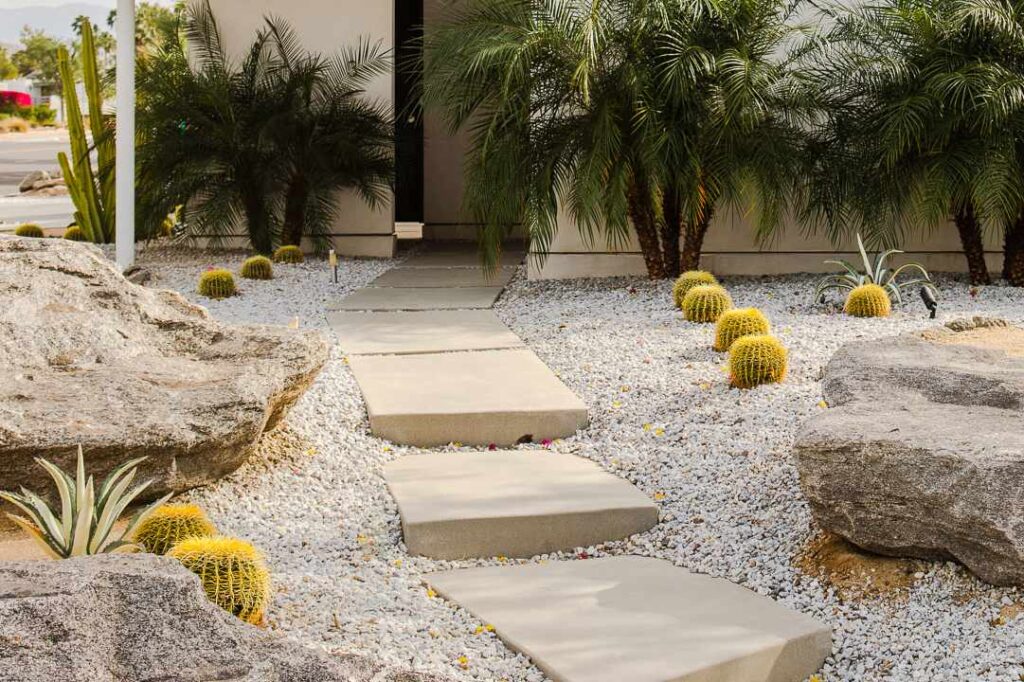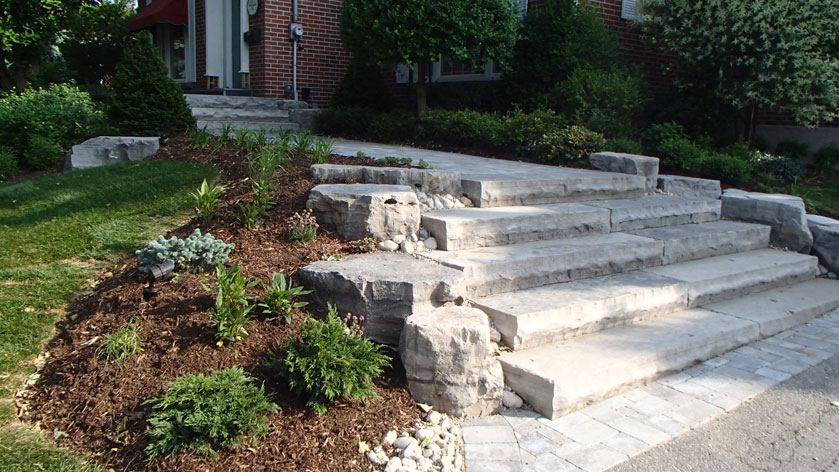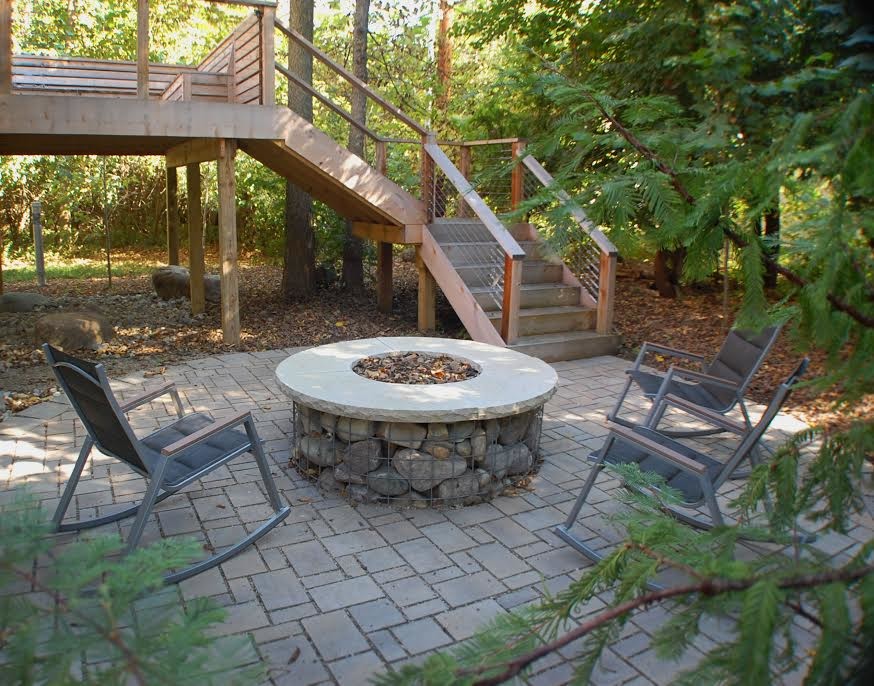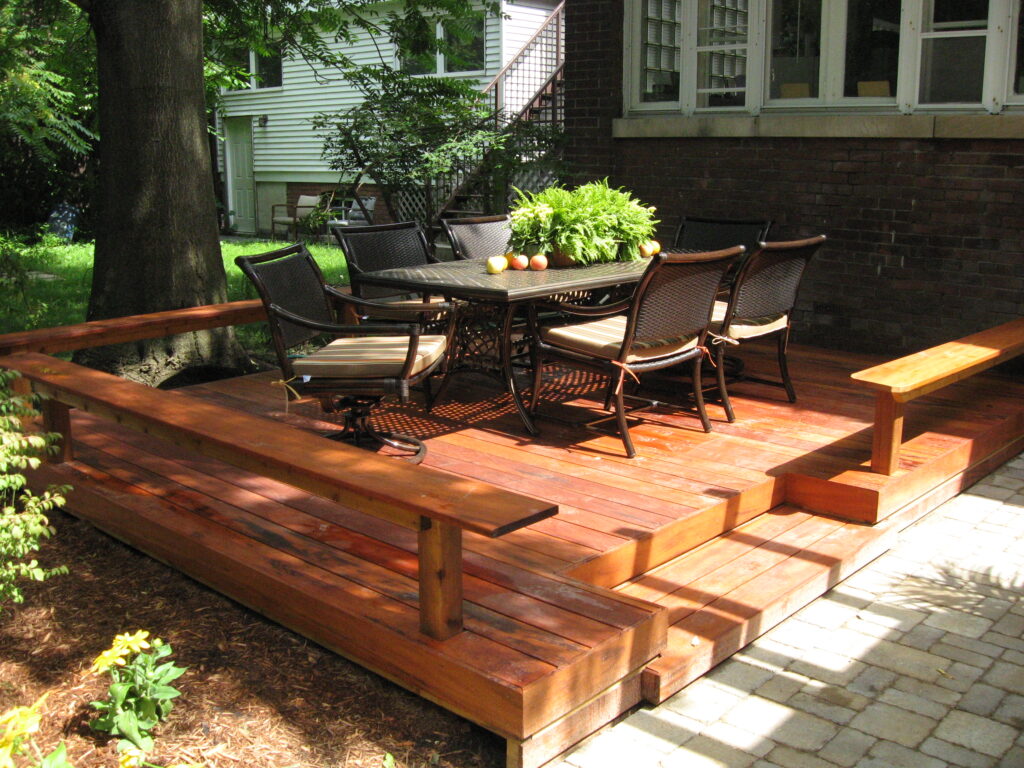When people plan an easy-to-maintain landscape, choosing the right plants is often the first thing that comes to mind. Choosing your hardscape and finishes carefully can go a long way toward reducing maintenance and increasing your enjoyment of outdoor activities.
Choose your ingredients wisely. Expert says there are more hardscape options that require less
maintenance than you might think. I love pavers and flagstone and crushed stone. I use it for paths
and mulch, emphasizing that proper installation is critical to longevity and ease of care. You need
someone with a lot of knowledge about flagstone installation. For crushed stone, we recommend
compacting it to a thickness of 6 inches.
Although wood and composite are solid choices for raised decks and raised garden bed structures,
expert believes they are less desirable for other uses in the yard. It requires more maintenance and
the wood shouldn’t be in contact with the soil. Dust can cause wood to rot.

The materials a designer chooses will depend on the site itself and the overall landscape design. Expert uses decomposed granite in areas with little or no slope. This reduces runoff and reduces the need to replenish material on a regular basis. Expert also likes broken pebbles and other angular pebbles. The pieces lock together and provide an easier surface to walk on or roll on, unlike round beach pebbles.
Expert, who manages the company’s landscape maintenance, says one advantage of decomposed granite is that when installed correctly, it requires little maintenance due to its penetrating weed barrier and compact application. Gravel, by contrast, can move a little more and cause accessibility issues.

Explore your options. The expert team also loves using packaging. For larger areas, such as driveways, expert may choose brick with gravel joints. This will allow the water to drain and move into adjacent beds instead of running into the street.
Cement is another option, but for both extensive and permeable applications, it requires a little more work. In general, surfaces need to be cleaned regularly.
Work with local ingredients. Expert’s first choice of paving material was natural stone. Natural stone wears beautifully and can be reused at the end of the life of the hardscape. Another advantage of expert is that natural stone, especially local types, blends well with local aesthetics. Where I live, flagstone, granite and schist complement the landscape and architecture of the Buffalo NY USA area.
Plan for a long life. Expert likes to use natural materials such as stone or classic clay paving
bricks. We start with the materials we use to build our homes and make sure there are
complementary choices that can be used for walks or patios. Expert adds that natural materials are
durable and can also improve design aesthetics.
Overall durability is another advantage of natural materials. Expert says it doesn’t break down like
manufactured packaging. It could still be in effect 50 years from now when your grandchildren are
living in your home. Expert’s favorite stones for patios include limestone and bluestone. For walls,
he gravitates to Wisconsin or Indiana limestone.
Plan for localized issues. Expert’s diverse landscaping projects include small backyards and rooftop terraces in (Add Place Name) and large properties in suburban and rural areas. His two favorite paving materials for small yards and terraces are porcelain and travertine. Pavers get a good power wash once a year. He advises homeowners to use light travertine in shady areas to brighten things up.
Designer also likes to use compacted pea gravel at least 11⁄2 to 2 inches thick. It’s good for the animals, it makes you feel light when you walk, and it’s a sustainable choice. He added that while gravel is a popular look, it can make it more difficult to collect and clean leaves.
Consider unexpected choices. Designer plans to add tree paving to the landscape, but he’s thinking carefully about what to choose and where to go. Resistant wood, such as black locust, which is native to our area, is a good choice. Instead of placing it directly on the ground, designer placed pea gravel underneath it.

Make it breathable. Whenever possible, architect uses permeable pavers that allow rainwater to seep into the ground below. This helps with drainage and keeps soil moisture higher year-round. She often recommends gravel and decomposed granite.
Another option that architect likes is sand-lined pavers. Place it on top of the base gravel and sand with decomposed granite, gravel or polymer sand in between. Designers recommend choosing flagstone or limestone thick enough for its weight to hold the pavers in place. Using sandstone is less expensive to install than wet stone and provides a more organic, finished result.






услуги по продаже аккаунтов продажа аккаунтов
маркетплейс аккаунтов соцсетей платформа для покупки аккаунтов
профиль с подписчиками https://magazin-akkauntov-online.ru
перепродажа аккаунтов продажа аккаунтов соцсетей
маркетплейс аккаунтов услуги по продаже аккаунтов
безопасная сделка аккаунтов площадка для продажи аккаунтов
купить аккаунт магазин аккаунтов
Account Buying Service Account market
Account Selling Platform Ready-Made Accounts for Sale
Account market Account Acquisition
Accounts marketplace Sell Account
Account Trading Platform Account market
Verified Accounts for Sale Buy Pre-made Account
Sell accounts Secure Account Sales
Account market Ready-Made Accounts for Sale
Account Trading Service Buy and Sell Accounts
Account Purchase Gaming account marketplace
Account Trading Account Trading
website for selling accounts verified accounts for sale
accounts marketplace account trading platform
verified accounts for sale https://socialaccountssale.com
verified accounts for sale sell accounts
buy accounts accounts for sale
ready-made accounts for sale account purchase
account buying platform https://socialaccountsdeal.com/
account sale sell account
account trading service https://discountaccountsmarket.com
purchase ready-made accounts account acquisition
account trading platform account store
guaranteed accounts secure account sales
account trading platform https://accounts-buy.org
account trading service purchase ready-made accounts
account trading account exchange service
account exchange service account market
buy pre-made account account buying service
purchase ready-made accounts account selling platform
account acquisition buy and sell accounts
website for buying accounts buy pre-made account
accounts market online account store
sell pre-made account gaming account marketplace
gaming account marketplace verified accounts for sale
account trading platform account purchase
account acquisition gaming account marketplace
account sale account market
website for selling accounts accounts marketplace
account selling service database of accounts for sale
marketplace for ready-made accounts https://accounts-offer.org/
online account store https://accounts-marketplace.xyz
social media account marketplace accounts market
account trading https://social-accounts-marketplaces.live
account exchange https://accounts-marketplace.live
account market https://social-accounts-marketplace.xyz
sell account https://buy-accounts.space/
gaming account marketplace buy-accounts-shop.pro
sell accounts accounts market
account selling platform account market
account purchase https://accounts-marketplace.online/
buy and sell accounts buy accounts
магазин аккаунтов https://akkaunty-na-prodazhu.pro/
маркетплейс аккаунтов https://rynok-akkauntov.top
площадка для продажи аккаунтов https://kupit-akkaunt.xyz/
маркетплейс аккаунтов https://akkaunt-magazin.online/
магазин аккаунтов https://akkaunty-market.live
маркетплейс аккаунтов соцсетей https://kupit-akkaunty-market.xyz
покупка аккаунтов akkaunty-optom.live
биржа аккаунтов online-akkaunty-magazin.xyz
маркетплейс аккаунтов https://akkaunty-dlya-prodazhi.pro
маркетплейс аккаунтов соцсетей https://kupit-akkaunt.online
facebook ads accounts facebook ad accounts for sale
buy facebook ad accounts https://buy-ad-accounts.click/
buy facebook account for ads https://buy-ad-account.top
facebook ads accounts https://buy-ads-account.click
buy facebook ads manager https://ad-account-buy.top
facebook ads account buy https://buy-ads-account.work
buy fb ads account ad-account-for-sale.top
fb accounts for sale https://buy-ad-account.click
facebook accounts for sale fb account for sale
adwords account for sale buy aged google ads account
google ads account buy https://buy-ads-accounts.click
buy facebook profiles https://buy-accounts.click
google ads account buy https://ads-account-for-sale.top
google ads agency account buy buy google ads threshold accounts
google ads agency accounts https://buy-ads-invoice-account.top
buy google ads threshold account https://buy-account-ads.work
buy google ads verified account https://buy-ads-agency-account.top
google ads reseller https://sell-ads-account.click
google ads agency account buy https://ads-agency-account-buy.click
buy facebook bm https://buy-business-manager.org/
sell google ads account https://buy-verified-ads-account.work
facebook business manager account buy https://buy-bm-account.org/
facebook bm account buy-business-manager-acc.org
unlimited bm facebook https://buy-verified-business-manager-account.org
verified bm for sale https://buy-verified-business-manager.org
Within this platform, find an extensive selection of online casinos.
Searching for traditional options latest releases, you’ll find an option for any taste.
Every casino included checked thoroughly for trustworthiness, so you can play securely.
1win
Additionally, this resource offers exclusive bonuses along with offers targeted at first-timers including long-term users.
Thanks to user-friendly browsing, finding your favorite casino happens in no time, making it convenient.
Be in the know on recent updates with frequent visits, since new casinos appear consistently.
facebook bm account verified facebook business manager for sale
unlimited bm facebook https://buy-business-manager-verified.org
buy fb bm https://buy-bm.org/
buy facebook business manager accounts verified-business-manager-for-sale.org
buy verified business manager buy-business-manager-accounts.org
buy tiktok business account https://buy-tiktok-ads-account.org
tiktok ad accounts https://tiktok-ads-account-buy.org
tiktok agency account for sale https://tiktok-ads-account-for-sale.org
buy tiktok ads https://tiktok-agency-account-for-sale.org
tiktok ads account buy https://buy-tiktok-ad-account.org
tiktok ads account for sale https://buy-tiktok-ads-accounts.org
tiktok ad accounts https://buy-tiktok-ads.org
buy tiktok ads account https://buy-tiktok-business-account.org
buy tiktok ad account https://tiktok-ads-agency-account.org
buy facebook accounts for ads online account store buy accounts
buy facebook accounts cheap account trading platform find accounts for sale